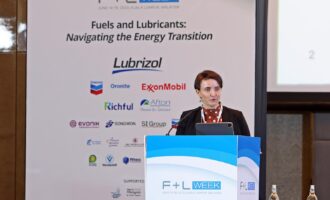
Lubrication challenges for fuel-agnostic engines
Despite the arrival of electrification and a rapidly changing transportation landscape, the internal combustion engine (ICE) will be around for a long time. Even in a doomsday scenario, there will still be 43 million new units manufactured in 2035, says Dr. Z. George Zhang, vice president, R&D, International, of Valvoline Global Operations.
A fuel-agnostic engine platform is one of the easiest and the most economical way of utilising already available infrastructure. There are certain applications where the ICE fueled by low- or zero-carbon energy could play a vital transitional role, says Zhang, who was speaking at F+L Week 2023 in Kuala Lumpur, Malaysia, on June 14. The Valvoline representative indicated that converting existing ICE platforms to use other fuel sources does not require significant effort.
The lubrication principles for engines operating with alternative fuels are the same as fossil fuel vehicles. Although, special properties and combustion characteristics of the fuels may require new components or a change in formulation approach.
During his presentation on Lubrication Challenges for Fuel Agnostic Engines, Zhang described some of the challenges for lubricant formulators. In particular, he highlighted several considerations relating to hydrogen (H2) combustion engines.
Hydrogen-fueled ICEs use direct injection fueling to increase volumetric efficiency and mitigate knock, pre-ignition, and backfire. Nitrous oxide is unavoidable, so the lubricants will need to deal with oxidation and nitration, says Zhang. Higher compression ratios also increase the risk of preignition, requiring manufacturers to formulate to minimise deposits and ensure careful lubricant component selection. Calcium and sodium detergents have been shown to promote low-speed pre-ignition (LSPI), while molybdenum and ZDDP tend to suppress LSPI. Zhang also outlined challenges relating to embrittlement and noted perceptions around the safety of H2.
Biodiesel is an alternative fuel composed of fatty acid methyl esters (FAME) derived from renewable sources. Zhang noted several lubrication concerns including the higher tendency of fuel dilution, viscosity increases, wax formation, oxidative stability and corrosivity. Renewable diesel, on the other hand, is a drop-in for diesel fuel so there are no additional requirements for lubricants, he says. E-fuels are also a drop-in replacement for traditional fossil fuels.
Ammonia is probably best suited to be an H2 source, says Zhang. It is associated with a pungent smell, is hygroscopic, toxic, reactive and corrosive, and has a weak base in nature. Lubricants considerations include new/more corrosion inhibitors and new components to deal with deposit formation possibly caused by aminification, he says. Aminification is a type of reaction caused by the combination of a carboxylic acid and an amine group.









